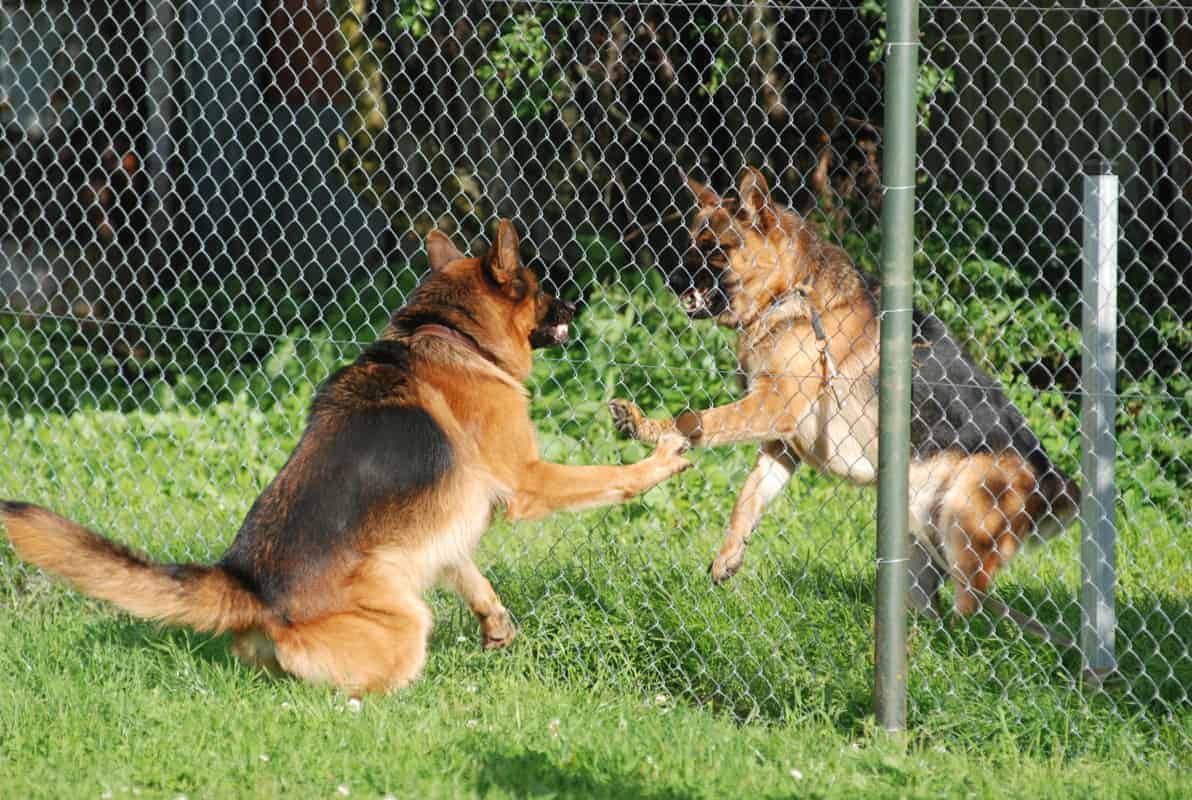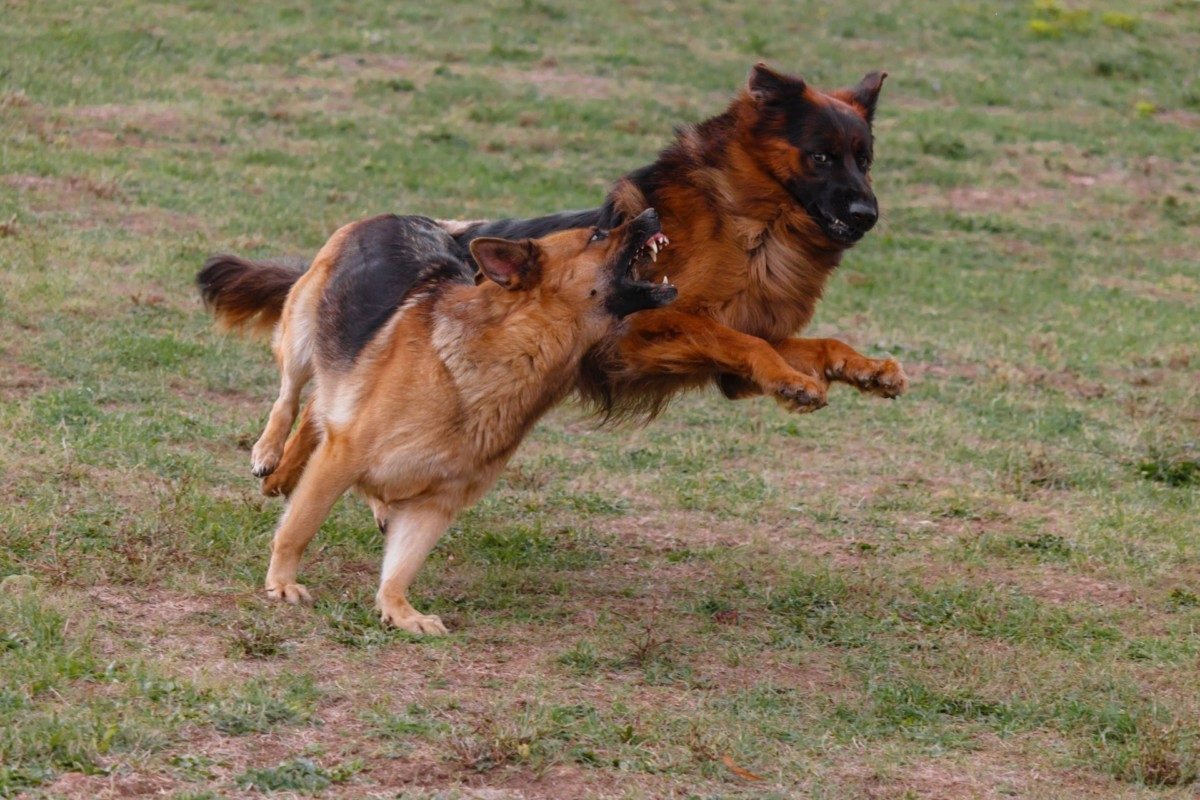German Shepherds are known to be loyal, protective, highly intelligent, and love to obey, and this is why they are often used in law enforcement. You’ve probably noticed your GSD acting protective when he sees a stranger coming toward you. When this happens, you may see your German Shepherd raise his hackles.
Raised hackles in German Shepherds (also known as piloerection) is an involuntary response that causes the dog’s hair on the shoulders and along the back to stand up on end. This can occur for various reasons, including aggression, defensiveness, fear, excitement, anxiety, nervousness, or arousal.
If you’ve ever taken your German Shepherd out for a walk and noticed him barking at another person or dog while his hair stands on end, this article has all the answers to why this may occur.
Most German Shepherds experience raised hackles, a process known as piloerection. It is a natural occurrence and nothing to worry about. This article will look at piloerection in more detail, exactly what causes it, and why you should be aware of it.

Welcome to the world of German Shepherds and raised hackles. Let’s begin!
German Shepherd Hackles
If you own a German Shepherd, there is no doubt you will adore your very loyal, protective, and affectionate dog. German Shepherds are well-known for forming an intense bond with their owners, but some people wrongly believe they are over-aggressive.
As long as your dog has been well socialized and trained he will be well-behaved and friendly – but German Shepherds can still be distant and somewhat aloof towards strangers as it’s in their nature.
When German Shepherd owners start noticing their dogs’ hairs standing on end, sometimes they may worry about aggression. While aggression is one potential reason, it’s not the only emotion your dog may be experiencing.
A dog’s hair standing on end is called piloerection, and it’s a common thing among all breeds, not just German Shepherds. Piloerection is an emotional reflex that happens in all dogs, and it isn’t a behavioral trait. Just think of it as being the same as when humans get goosebumps.
By having his hairs along his shoulders and back stand up on end, your dog is making himself appear bigger than he actually is.
When your dog’s hackles raise, he is experiencing some type of emotion that’s causing this piloerection reaction. There’s no need to be concerned about piloerection, however, depending on your dog’s personality, you may need to watch out for this trait – especially if your dog is displaying other signs of aggression.
Here’s a helpful 2-minute video from canine behaviorist Shirin Merchant which features a gorgeous German Shepherd Dog. Shirin explains that raised hackles in dogs are not just a sign of aggression and how it’s important to read the full body language of dogs to establish what exactly they are thinking and feeling:
What is Piloerection?
Let’s now assess more about how piloerection works so that you understand how it relates to your German Shepherd Dog. Small hairs that are found on a dog’s backbone, from his neck to the base of his tail, feature the ability to create piloerection. Just as the name implies, the emotional reaction that he is unable to control makes your dog’s hair, or pilo, stand right up.
All dogs, including German Shepherds, have muscles in their skin. Those muscles then connect with the follicles in their hair, and that can create piloerection. Piloerection is an involuntary reaction that happens when a dog is experiencing certain emotions.
Raised hackles in German Shepherds may occur around the shoulders only, or the shoulders and the length of the backbone, or it may occur at the shoulders and the base of the tail with a gap in between.
A study from Animals on dog communication states that it remains inconclusive whether the location of the raised hackles on the dog could suggest the emotional state that the dog is experiencing.
Sometimes piloerection happens because your dog is excited, or sometimes it happens because your dog is afraid or is being defensive.
The raised hackles make your dog look bigger than he. It is a visual warning to a potential enemy or threat.
In certain dog breeds, piloerection is a bit more difficult to notice, especially if you own a curly or long-haired dog. If you have one of these dog breeds, you’ll notice the raised hair where the hair is shorter, usually around the shoulders.
One reason why German Shepherds are known for piloerection is because of their wiry, thick fur. The way their coats naturally appear makes piloerection very noticeable in this breed.
Be aware that a heightened German Shepherd experiencing raised hackles should not be startled or touched. However, all dogs are different and you will get to know your dog’s body language.
My GSD has piloerection all the time – usually when the mailman attends the front of the house when she is being protective, or if a squirrel runs along the back fence and she is excited and her prey drive takes over! It only lasts for a matter of seconds and so I do not worry as I know it’s just a natural thing for her to do.
What Causes Piloerection?
This section will now cover exactly what emotions may be causing your German Shepherd to experience piloerection.
1. Aggression and Defensiveness
Another reason why German Shepherds are well-known for piloerection is due to their natural traits which cause their emotions to trigger the hairs to stand on end. One of these well-known traits is aggression.
If something triggers your German Shepherd to bark, such as a stranger approaching your property your dog may go into protection mode. He is being naturally defensive of both his territory and of you! Remember, German Shepherds were originally bred as herding dogs to watch and protect flocks of sheep.
Since the raised hairs on your dog’s back are involuntary, you may not always be witnessing aggression. Your dog could simply be aroused, upset, surprised, or feeling anxious.
However, you need to pay attention to any other body language your dog might be displaying while he is experiencing piloerection. To learn more about dog body language, I have a comprehensive article here – How Do German Shepherds Communicate?
If you are concerned re your GSD developing over aggressive behavior, it’s important to be aware of other signs that he may display, such as growling or snarling, showing his teeth, pinned back ears, stiff posture, and tail vertical or arched over his back. If this becomes an issue you may need extra training with the help of a professional.
2. Excitement
It’s also not uncommon for the hairs on your German Shepherd’s back to stand up if your dog is experiencing excitement. Similar to aggression, creating an emotional response in a German Shepherd, excitement creates a similar piloerection response.

For example, when you just get home from work your German Shepherd is so happy to see you that his hair stands on end. Or consider when your dog meets a new dog friend. Chances are, your dog will wag his tail and sniff the other dog, but he will still be demonstrating some piloerection from the excitement. This emotion is also linked to anxiety as discussed below.
3. Anxiety
With excitement, your dog may also experience anxiety, as the situation experienced may make your dog have both emotions. Let’s go back to the situation when your German Shepherd meets a new dog friend. One of the reasons why his hair stands on end when first meeting a new friend is also anxiety mixed with excitement. Once your dog feels comfortable around the other dog, his hair will relax and go back to normal.
4. Arousal
Some German Shepherds also raise their hackles when they are playing with their owner or another dog. When this happens, your dog isn’t being aggressive at all – it’s just dog play! If your dog’s hair experiences piloerection while you are playing with him, this just goes back to your dog being aroused or excited. When dogs play, they often naturally show piloerection, mostly because they are excited.
Final Thoughts
Piloerection is a natural reaction in your German Shepherd, and not something that can be controlled. However, it’s still important to pay attention to your dog’s other body language while he experiences raised hackles.
Any number of emotions can cause piloerection in dogs from aggression, defensiveness, dominance, fear, excitement, arousal, or anxiety.
German Shepherds are more prone to piloerection because of their natural behavioral traits, which includes their overwhelming desire to protect. This is one of the many reasons why GSDs are used in the police and military, as well as in search and rescue and as service or therapy dogs.
Piloerection is more noticeable in German Shepherds than some other breeds due to their thick wiry outer coat. Paying attention to your German Shepherd’s piloerection can help you understand your dog’s feelings over time, and this will help to increase your friendship and bond with your dog.





